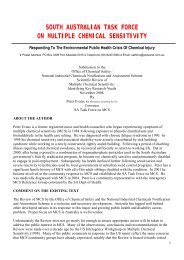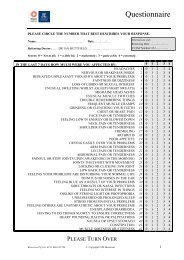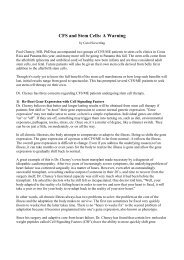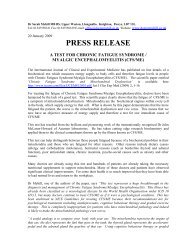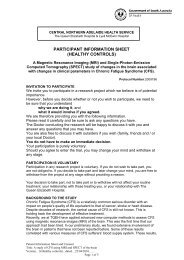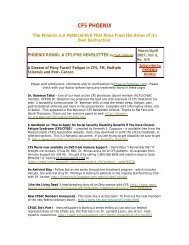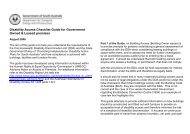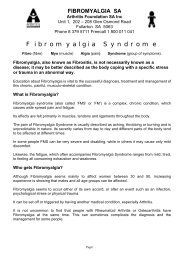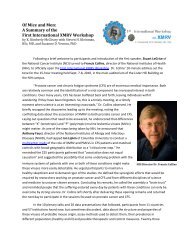30 S. Stisi et al.trols, they present low 24-h serum cortisol levels;abnormal circadian pattern of cortisol concentrationand blunted serum cortisol responses to corticotropin-releasinghormone (CRH), i.e., whenCRH is released by the hypothalamus, there is adisproportionately high release of corticotrophinby the pituitary gland and disproportionately smallrelease of cortisol by the adrenal gland. This latterresult suggests an abnormal response of FMS patientsto stress, and thus, an inadequate reaction toa number of stressful events, such as trauma or infection(81). Interestingly, when synthetic CRH isinjected in FMS patients this abnormal response isnot present, and the patients behave like normalcontrol subjects. This suggests that there might bea different sensitivity of adrenal tissue to endogenousand exogenous CRH in FMS. On the whole,however, there is no evidence to support any structuralabnormality in the endocrine organs whichcomprise the HPA axis; thus, it seems that thechanges found in hormone production under activationof the axis are functional in patients withFMS (82).Dysregulation of the HPA axis can potentially accountfor several symptoms in FMS, including fatigue,primarily, as well as depression and sleepdisturbance; these symptoms are often present insubjects with a reduced activity of the axis (as inwithdrawal from glucocorticoid therapy, or in Addison’sdisease) or in individuals with geneticallyaltered HPA axis function (83). A link with pain isalso present. For instance, a recent study byMcLean et al. (84) showed a significant associationbetween levels of CRH in CSF and pain levels inpatients with FMS.Increased central levels of CRH also produce analgesiain animals (85). Activation of the HPA axisstimulates the release of the opioid beta-endorphin,corticotrophin, and cortisol, which, thanks to itsanti-inflammatory properties, has the potential ofreducing pain (83), though it should be underlinedthat in FMS, specifically, corticosteroids are noteffective (86).The hypothalamic-pituitary-thyroid axis(HPT-axis)The hypothalamic-pituitary-thyroid axis functionwould seem altered in FMS patients as the releaseof thyrotropin-releasing hormone stimulates lessthyrotropin, triiodothyronine and thyroxin productionthan normal. This is possibly the result of somepituitary dysfunction secondary to the documentedimpaired stress response in FMS (87).The hypothalamic-pituitary-gonadal axis(HPG-axis)Though not many studies have been performed inthis area, the results of those available so far provideno evidence for any abnormality in gonadotropinsecretion or gonadal steroid levels inFMS (88, 89). Thus a deficit of sex hormones doesnot appear to be part of the manifestations of FMS.Growth hormone (GH)A number of research studies have been devoted toevaluation of circulating levels of growth hormonein FMS. These levels tend to be normal duringwaking hours and are slightly reduced during sleep.It is well known that stage 4 of sleep is disruptedin FMS, and this is the phase when GH is secreted;it remains to be established if the decreasedGH is the consequence of disrupted sleep or of adecreased GH-stimulation by sleep. FMS patientshave increased levels of corticotrophin, and corticotrophinincreases hypothalamic somatostatin secretion.Since somatostatin is one of the hormonesthat inhibits GH via the hypothalamic-pituitary portalsystem this may also contribute to their relativeGH insufficiency. Supplementation with GH hasprovided relatively positive results, at least in asubpopulation of FMS patients; however, the highcosts of the hormone, combined with the unpleasantnessof the modality of administration do not encouragethe use of this therapy on a large scale(90).FMS patients have been shown to present withmany neurochemical alterations, e.g., norepinephrinedeficit, lower concentrations of beta-endorphinin peripheral blood mononuclear cells (91), lowserum serotonin levels and low level of the serotoninmetabolite (5-HIAA) (92) in the CSF, increasedlevels of substance P and nerve growth factor(NGF) - a promoter of substance P synthesis -in CSF (93, 94), abnormal dopaminergic transmission.Regarding the latter, a recent review by Wood(95) focused on the mesolimbic dopaminergic systemas a possible contributor to central pain states;in animals acute stress activates mesolimbicdopamine neurons inducing analgesia; however,prolonged stress decreases mesolimbic dopaminergicoutput and creates a hyperalgesic state. A recentstudy by Malt et al (96) compared the responseof female patients with FMS and healthy controlsto buspirone, showing an increased prolactin responsein the FMS group, a result that was attributedby the researchers to altered dopamine sensitivityin FMS.
Etiopathogenetic mechanisms of Fibromyalgia Syndrome 31Collectively, these neurotransmitter abnormalitiesmay play a role in HPA function and control in FMS(97).To date, however, the means by which HPA axisdysfunction develops in FMS still remains unclear.Autonomic nervous system (ANS)amplificationThe ANS is the principal regulatory system of thebody; it maintains essential involuntary functions,e.g., the vital signs (blood pressure, pulse, respiration,and temperature) and balances the function ofall internal organs. It is a complex network activatedby nerve centers located in the spinal cord,brain stem, hypothalamus and thalamus; centersthat also receive input from the limbic area andother higher brain regions.Emotions such as fear or anger, therefore, produceimmediate biological responses, such as pupil dilatationor tachycardia. Through their neurotransmitters(catecholamines for the sympathetic system),the two divisions of the peripheral autonomicsystem, sympathetic and parasympathetic, haveantagonistic actions on most functions of the body,but their proper balance is essential to preservehomeostasis (98).A number of studies have demonstrated alterationsof the ANS in FMS, the most recent ones usingmethodologies such as power spectrum analysis ofheart rate variability (HRV) and tilt table test.Vaeroy, et al. (99) demonstrated a decreased sympatheticresponse to painful and auditory stimuli.Studies with power spectrum analysis of HRVshowed decreased 24-h HRV with persistent nocturnalsympathetic hyperactivity associated withincreased number of awakenings, decreased sympatheticresponse to several stressors and abnormalsympathovagal responses during postural changes.The HRV studies reflect a basal autonomic state ofhyperactivation characterized by increased sympatheticand decreased parasympathetic tone (i.e., asympathetic basal hyperactivity with hyporeactivity)(100, 1<strong>01</strong>). Abnormal HRV in FMS, consistentwith excessive sympathetic activity, especially inwomen, has been reported by several investigators(99). In a recent study, Furlan, et al. (102) investigatedwhether FMS is characterized by alterationsin the cardiovascular autonomic response to gravitationalstimulus (using the stepwise tilting); theyfound a reduced ability to enhance the sympatheticactivity to the vessels and withdraw the vagalmodulation to the sino-atrial node.The dysautonomia in FMS would thus be characterizedas a sympathetic nervous system that ispersistently hyperactive but is hyporeactive tostress. This apparent paradox (sympathetic hyperactivitywith hyporeactivity) nevertheless agreeswith the basic physiological principle showing thatchronic hyperstimulation of the beta-adrenergicreceptors leads to receptor desensitization anddown-regulation (99). It has been suggested thatthe dysautonomia in FMS could be at least in partresponsible for the pain of the syndrome - similarlyto what happens in classic sympathetic-maintainedpain conditions.ANS dysfunction may also explain a number ofthe other clinical symptoms of FMS. Due to a ceilingeffect, the hyperactive sympathetic nervoussystem in FMS would become unable to further respondto different stressors, thus explaining theconstant fatigue and morning stiffness. Relentlesssympathetic hyperactivity may explain sleep disorders,anxiety, pseudo-Raynaud’s phenomenon,sicca symptoms, and intestinal irritability.Further studies support the altered sympatheticfunction in FMS. Anderberg, et al. (103) foundhigh serum levels of neuropeptide Y (NPY) in FMSvs healthy controls, which was interpreted as a signof increased sympathetic activity (prolonged and/orrepeated stress) since NPY is co-released with noradrenalinefrom sympathetic neurons. Wallace, etal. (104) showed high serum concentrations of IL-8 in FMS vs healthy controls, another interestingfinding since IL-8 has been associated with sympatheticallydependent hyperalgesia. Along thesame line, Martinez-Lavin (98) showed that a subcutaneousinjection of noradrenaline induced painmore frequently and with a higher intensity in FMSpatients vs RA patients or vs healthy controls.The HPA axis and the ANS have multiple sites ofinteraction. At present it is not clear if decreasedANS activity and altered neuroendocrine functionmay contribute to the pain and related symptomsof the syndrome or if they are the consequence ofpain.It is frequent for FMS patients to present a historyof emotional or physical trauma before the onset ofFMS symptoms (105). Stress is known to reduce theneuroendocrine and ANS stress response; therefore,stressful events may represent the triggering factorfor the neuroendocrine and ANS abnormality inFMS. However, it is also possible that the symptomsof FMS (pain, sleep disturbance, fatigue, etc.), experiencedon a chronic basis, may affect the functionof the HPA axis and ASN. As a matter of fact,a number of studies have shown that a reduction of
- Page 2 and 3: 2 P. Sarzi-Puttini et al.The meetin
- Page 4 and 5: 4 M. Cazzola et al.(2). In the earl
- Page 6 and 7: 6 M. Cazzola et al.enough to meet F
- Page 8 and 9: 8 M. Cazzola et al.Table I - Charac
- Page 10 and 11: 10 M. Cazzola et al.Table IV - Cond
- Page 12 and 13: 12 M. Cazzola et al.teria, three su
- Page 14 and 15: 14 M. Cazzola et al.tients with a n
- Page 16 and 17: 16 G. Cassisi et al.The cardinal fe
- Page 18 and 19: 18 G. Cassisi et al.StiffnessIn FM
- Page 20 and 21: 20 G. Cassisi et al.Autonomic and n
- Page 22 and 23: 22 G. Cassisi et al.Associated symp
- Page 24 and 25: 24 G. Cassisi et al.46. Coleman RM,
- Page 26 and 27: 26 S. Stisi et al.sensitization,”
- Page 28 and 29: 28 S. Stisi et al.Sum oflife-events
- Page 32 and 33: 32 S. Stisi et al.stress, obtained,
- Page 34 and 35: 34 S. Stisi et al.50. Harris RE, Cl
- Page 36 and 37: ORIGINAL ARTICLEReumatismo, 2008; 6
- Page 38 and 39: 38 F. Atzeni et al.lalanine (17), a
- Page 40 and 41: 40 F. Atzeni et al.clearer and it m
- Page 42 and 43: 42 F. Atzeni et al.healthy control
- Page 44 and 45: 44 F. Atzeni et al.and/or verbal (e
- Page 46 and 47: 46 F. Atzeni et al.for study purpos
- Page 48 and 49: 48 F. Atzeni et al.mimics of fibrom
- Page 50 and 51: ORIGINAL ARTICLEReumatismo, 2008; 6
- Page 52 and 53: 52 P. Sarzi-Puttini et al.A larger
- Page 54 and 55: 54 P. Sarzi-Puttini et al.from 1966
- Page 56 and 57: 56 P. Sarzi-Puttini et al.rational,
- Page 58 and 59: 58 P. Sarzi-Puttini et al.49. Toffe
- Page 60 and 61: 60 R. Casale et al.cal exercise and
- Page 62 and 63: 62 R. Casale et al.definition of
- Page 64 and 65: 64 R. Casale et al.are more or less
- Page 66 and 67: 66 R. Casale et al.trol associated
- Page 68 and 69: 68 R. Casale et al.32. Lewit K. The
- Page 70 and 71: ORIGINAL ARTICLEReumatismo, 2008; 6
- Page 72 and 73: 72 L. Altomonte et al.In a clinical
- Page 74 and 75: 74 L. Altomonte et al.Table II - We
- Page 76 and 77: 76 L. Altomonte et al.treatments de



